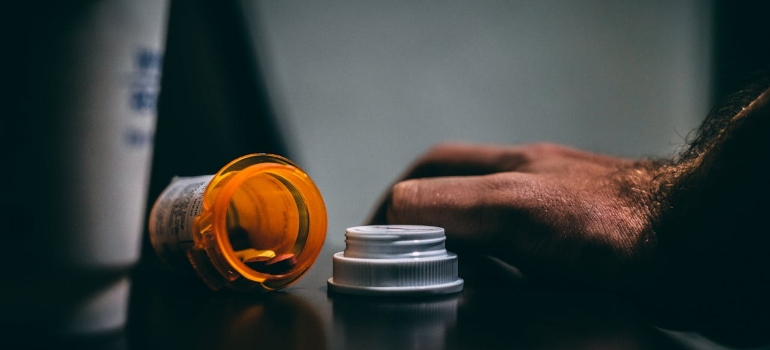Addiction can happen to anyone. It is not a matter of race, socioeconomic status, age, religious beliefs, educational background, gender identity, or sexual orientation. Addiction also impacts more than just the person addicted – it impacts their family and community. You’ve most likely heard of the opioid epidemic in the United States, where roughly 21 to 29 percent of patients prescribed opioids for chronic pain misuse them and spiral from there. This issue has become a public health crisis with devastating consequences including increases in opioid misuse and related overdoses, as well as the rising incidence of neonatal abstinence syndrome due to opioid use and misuse during pregnancy. Why is opioid addiction so hard to overcome? We will explain the history behind opioids, the signs of opioid addiction and the treatment options available.
What are Opioids and Where Do They Come From?
“Opioid” is an umbrella term for both natural and synthetic painkiller drugs derived from or based on the poppy plant. The term “opiate” is used to define the drugs that use only natural opium poppy products. According to The Drug Enforcement Administration (DEA) Museum, the earliest reference to opium growth and use is in 3,400 B.C. when the opium poppy was cultivated in lower Mesopotamia (Southwest Asia). Today, opium is grown mainly by impoverished farmers on small plots in remote regions of the world. After being processed and sold to a dealer, the opium is brought to other countries to be sold to consumers. Opioids include:
- Opium
- Codeine
- Fentanyl
- Heroin
- Hydrocodone
- Hydromorphone
- Methadone
- Morphine
- Oxycodone
- Oxymorphone
- Paregoric
- Sufentanil
- Tramadol

Opioids can be prescription medications, often referred to as painkillers or they can be so-called “street drugs”. Doctors most often prescribe opioids to relieve pain from dental procedures, surgeries, pain-inducing chronic illnesses, and injuries. According to The Drug Enforcement Administration (DEA) Museum, opium was actually known to ancient Greek and Roman physicians as a powerful pain reliever. It was also used to induce sleep and to give relief to the bowels.
What Is the Psychology of Opioid Addiction? How do Opioids Make You Feel?
Opioids bind to natural opioid receptors in the brain, mimicking specific chemicals that are related to sensations of pain relief, pleasure, and reward – creating fake endorphins. Since opioids have both pain relieving properties and positive psychological properties, they are among the most abused types of substances currently available. Using opioids for a long period of time can actually cause your brain to rely on those fake endorphins. Once your brain does this, it can even stop producing its own endorphins. The longer you use opioids, the more likely this is to happen.
Even when the medications are prescribed appropriately and taken as directed, they still have a high potential for causing addiction in some people. Regular use of these prescribed medications can increase your tolerance and dependence, requiring higher and more frequent doses. After a person becomes addicted, with or without knowing, they want more. Most of the time, their prescription has run out and doctors catch onto this and cannot prescribe them anymore – which is why many turn to heroin. Heroin is an opioid drug made from morphine. It is cheaper and stronger than prescription opioids, and much easier to get.
The National Institute on Drug Abuse reported that more than 2 million Americans abuse opioids. The U.S. Department of Health and Human Services (HHS) is focusing its efforts on improving access to treatment and recovery services such as West Virginia treatment center, promoting use of overdose-reversing drugs, strengthening our understanding of the epidemic through better public health surveillance, providing support for cutting-edge research on pain and addiction, and advancing better practices for pain management.

How Did the Opioid Epidemic Happen?
How did opium go from being a medical remedy to a serious health problem in the United States? The opioid epidemic has actually occurred in three waves.
- The first wave came in the early 1990s. According to the National Institute on Drug Abuse, pharmaceutical companies assured the medical community that patients would not become addicted to prescription opioid pain relievers, and healthcare providers began to prescribe them at greater rates. It became clear that communities where opioids were readily available and prescribed liberally were the first places to experience increased opioid abuse and diversion (the transfer of opioids from the individual for whom they were prescribed, to others, which is illegal).This subsequently led to widespread diversion and misuse of these medications before it became clear that these medications could indeed be highly addictive.
- The second wave came in 2010, with a rapid increase in heroin overdoses/deaths. The early efforts to decrease opioid prescribing began to take effect, prescription opioids started becoming harder to obtain. Then, addicts began to focus on heroin – a cheap, widely available, and potent illegal opioid. One study found that 86% of individuals had previously used opioid painkillers for non-medical purposes before turning to heroin.
- The third wave came in 2013, when there was an increase in overdoses/deaths related to synthetic opioids, especially fentanyl as one of the most dangerous synthetic drugs nowadays. In 2016 alone, there were over 20,000 deaths from fentanyl and related drugs.
Risk Factors for Opioid Addiction
A number of genetic, environmental, and behavioral factors can cause substance use disorders. These are some of the known risk factors of opioid addiction:
- Personal history of substance abuse or misuse
- Family history of substance addiction or misuse
- Heavy use of tobacco
- History of mental health disorders, like severe depression or anxiety
- Unemployment or poverty
- Regular contact with high-risk people or high-risk environments
- Risk-taking or thrill-seeking behavior
- Severe pressures at home or work
- Previous criminal activity
- Constant stressors in life

Women have a unique set of risk factors for opioid addiction. Furthermore, women are more likely than men to have chronic pain. Compared with men, women are also more likely to be prescribed opioid medications, to be given higher doses and to use opioids for longer periods. Women may also have biological tendencies to become dependent on prescription pain relievers more quickly than men.
Signs and Symptoms of Opioid Addiction
Detecting drug abuse early on is the most effective way of preventing opioid addiction from developing. But, it’s important to note that someone struggling with opioid use disorder may not display symptoms right away. However, there may be signs that they need help over time. These signs can be physical, psychological, or behavioral. Here are some of the signs you should look out for.
Physical:
- Constricted, “pinpoint” pupils
- Excessive sweating
- Flushed, itchy skin
- Shaking
- Loss of coordination
- Taking shallow or slow breaths
- Intense nausea
- Vomiting
- Constipation
- Physical agitation
- Slurred speech
- Drowsiness/lightheadedness
- Nodding out
- Shaking
- Sweating
- Increased sexual arousal
Psychological
- Depression
- Increased anxiety/anxiety attacks
- Irritability
- Drastic mood swings that seem out of character
- Lowered motivation
- Being unable to stop using more than the recommended amount (if prescribed)
- Improved self-esteem
Behavioral:
- Poor decision making
- Abandoning important responsibilities
- Financial hardship
- Changes in sleeping patterns
- Eating more or less than usual
- Spending less time with family and loved ones
- Not bathing, changing clothes, or brushing their teeth
You may not see all of these signs from your loved one, but it’s important to watch over time to see if you pick up a couple or more.
Effective Treatment Options for Opioid Addiction
When it comes to treating opioid addiction, several options help individuals move forward in their recovery. Medication-Assisted Treatment West Virginia (MAT) combines specific medications, like methadone or buprenorphine, with regular counseling. This approach relieves withdrawal symptoms and cuts down on cravings, allowing individuals to focus on rebuilding their lives. MAT has helped many reduce the risk of relapse and start a stable recovery journey.

In addition to MAT, therapies like Cognitive-Behavioral Therapy for substance use disorders (CBT) and group therapy provide valuable support. CBT helps people recognize patterns and triggers connected to their addiction, while group therapy offers community support and accountability. Many treatment centers also include alternative therapies for a more well-rounded recovery experience. Effective treatment options for opioid addiction include:
- Medication-Assisted Treatment (MAT): Combines medications and counseling to reduce cravings.
- Cognitive-Behavioral Therapy (CBT): Teaches skills to handle triggers and change thought patterns.
- Group Therapy for addiction: Provides support, connection, and accountability.
- Alternative Therapies: Yoga, art therapy, and mindfulness activities to support emotional health.
Preventing Opioid Addiction: Education, Awareness, and Community Initiatives
In addition to individual therapy for addiction, preventing opioid addiction also starts with strong education and awareness programs. Teaching people about the risks of opioids, even when prescribed, can help them make informed decisions. Schools, healthcare providers, and community centers often run programs that focus on the dangers of misuse, the risk of addiction, and safe medication practices. When individuals understand the potential consequences of opioids, they are more likely to use them responsibly or seek alternatives when possible.
Community initiatives play an important role as well. Many towns and cities host events, workshops, and support groups to spread awareness and offer resources. These programs often include information on proper storage and disposal of medications to prevent misuse in the home. Community partnerships also encourage open discussions about opioid misuse, reducing stigma and making it easier for people to seek help. By promoting knowledge and connection, communities can create a safer environment and lower the risk of opioid addiction for everyone. Preventive strategies to reduce opioid addiction:
- Educational programs: Inform students and adults about the risks of opioid use.
- Community awareness events: Spread knowledge and offer resources on safe opioid practices.
- Medication safety campaigns: Promote safe storage and disposal of prescription opioids.
- Support groups and workshops: Emphasizing the power of social connections in addiction recovery can foster open discussions and reduce stigma around opioid addiction.

The Impact of Opioid Addiction on Families and Relationships
Opioid addiction affects not only the individual but also deeply impacts their family and relationships. Loved ones often experience emotional strain, worry, and frustration as they watch someone struggle with addiction. Trust can erode, and communication becomes tense or breaks down entirely. Family members may find themselves taking on additional responsibilities, leading to feelings of burnout and helplessness.
This strain on relationships can sometimes lead to cycles of conflict and resentment, making it harder for families to support their loved one’s recovery. However, support groups and family therapy for addiction can provide helpful guidance and coping strategies. These resources encourage healthy boundaries and open communication, helping families reconnect and rebuild trust as they navigate the challenges of opioid addiction together.
Protecting Your Household: Safe Practices for Opioid Storage and Disposal
If you are taking opioids, you are not the only one in your household who is in danger of misuse, addiction and overdose. Other members of your household are also vulnerable. This is what the American Society of Anesthesiologists suggests doing, to protect others:
- Always store opioids in a safe and secure place. Do not leave prescription bottles in the medicine cabinet, and keep the medication away from others, particularly young children. Children sometimes confuse medications for candy and end up swallowing them, which can lead to overdose. Other family members and visitors could also find prescription medications in the house and use them inappropriately.
- Never share your prescriptions. More than half of people who misuse prescribed opioids get them from a friend or relative, according to the Substance Abuse and Mental Health Services Administration.
- Don’t throw unused opioids in the trash. Improper disposal of prescription medicines can lead to other people finding and taking them.

Find Hope and Healing for Opioid Addiction at Harmony Ridge Recovery Center
If you think your loved one is addicted to opioids, know that there is help. Given the unique treatment and recovery challenges associated with heroin and opioid addictions, it’s important to seek help from professionals. If you think that a loved one is going through opioid addiction, contact our team at Harmony Ridge Recovery Center. Harmony Ridge Recovery Center is located in the Mid-Ohio Valley in Walker, West Virginia. Surrounded by 50 acres of lakes and forest land, it is the perfect place to begin a journey of any type. Our comprehensive treatment programs will set you up to succeed on your journey to recovery. If you or a loved one needs help, contact us today. We have a 24-hour helpline waiting to hear from you.



